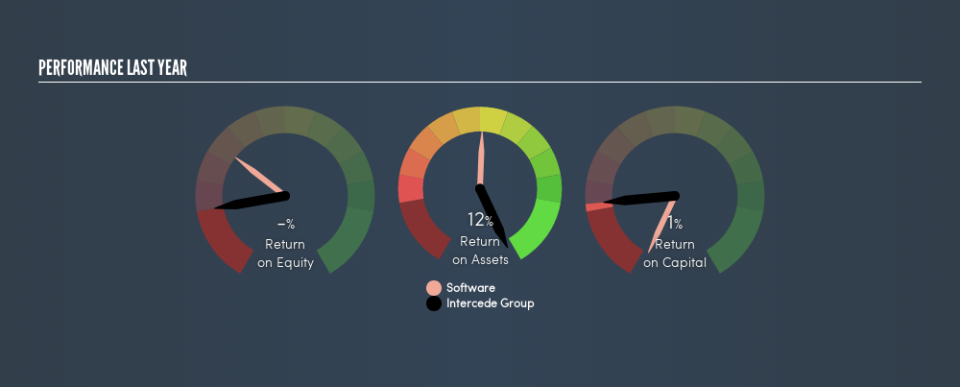Why Intercede Group plc’s (LON:IGP) Return On Capital Employed Might Be A Concern

Want to participate in a short research study? Help shape the future of investing tools and you could win a $250 gift card!
Today we are going to look at Intercede Group plc (LON:IGP) to see whether it might be an attractive investment prospect. Specifically, we'll consider its Return On Capital Employed (ROCE), since that will give us an insight into how efficiently the business can generate profits from the capital it requires.
First of all, we'll work out how to calculate ROCE. Next, we'll compare it to others in its industry. Last but not least, we'll look at what impact its current liabilities have on its ROCE.
Return On Capital Employed (ROCE): What is it?
ROCE is a measure of a company's yearly pre-tax profit (its return), relative to the capital employed in the business. All else being equal, a better business will have a higher ROCE. Ultimately, it is a useful but imperfect metric. Author Edwin Whiting says to be careful when comparing the ROCE of different businesses, since 'No two businesses are exactly alike.'
How Do You Calculate Return On Capital Employed?
Analysts use this formula to calculate return on capital employed:
Return on Capital Employed = Earnings Before Interest and Tax (EBIT) ÷ (Total Assets - Current Liabilities)
Or for Intercede Group:
0.0058 = UK£16k ÷ (UK£8.6m - UK£5.8m) (Based on the trailing twelve months to March 2019.)
Therefore, Intercede Group has an ROCE of 0.6%.
View our latest analysis for Intercede Group
Is Intercede Group's ROCE Good?
ROCE can be useful when making comparisons, such as between similar companies. In this analysis, Intercede Group's ROCE appears meaningfully below the 9.6% average reported by the Software industry. This could be seen as a negative, as it suggests some competitors may be employing their capital more efficiently. Regardless of how Intercede Group stacks up against its industry, its ROCE in absolute terms is quite low (especially compared to a bank account). There are potentially more appealing investments elsewhere.
Intercede Group reported an ROCE of 0.6% -- better than 3 years ago, when the company didn't make a profit. This makes us wonder if the company is improving.
When considering this metric, keep in mind that it is backwards looking, and not necessarily predictive. ROCE can be deceptive for cyclical businesses, as returns can look incredible in boom times, and terribly low in downturns. ROCE is, after all, simply a snap shot of a single year. Since the future is so important for investors, you should check out our free report on analyst forecasts for Intercede Group.
How Intercede Group's Current Liabilities Impact Its ROCE
Current liabilities include invoices, such as supplier payments, short-term debt, or a tax bill, that need to be paid within 12 months. The ROCE equation subtracts current liabilities from capital employed, so a company with a lot of current liabilities appears to have less capital employed, and a higher ROCE than otherwise. To counter this, investors can check if a company has high current liabilities relative to total assets.
Intercede Group has total liabilities of UK£5.8m and total assets of UK£8.6m. As a result, its current liabilities are equal to approximately 68% of its total assets. Current liabilities of this level result in a meaningful boost to Intercede Group's ROCE.
The Bottom Line On Intercede Group's ROCE
Unfortunately, its ROCE is also pretty low, so we are cautious about the stock. You might be able to find a better investment than Intercede Group. If you want a selection of possible winners, check out this free list of interesting companies that trade on a P/E below 20 (but have proven they can grow earnings).
If you are like me, then you will not want to miss this free list of growing companies that insiders are buying.
We aim to bring you long-term focused research analysis driven by fundamental data. Note that our analysis may not factor in the latest price-sensitive company announcements or qualitative material.
If you spot an error that warrants correction, please contact the editor at editorial-team@simplywallst.com. This article by Simply Wall St is general in nature. It does not constitute a recommendation to buy or sell any stock, and does not take account of your objectives, or your financial situation. Simply Wall St has no position in the stocks mentioned. Thank you for reading.

 Yahoo Finance
Yahoo Finance 
